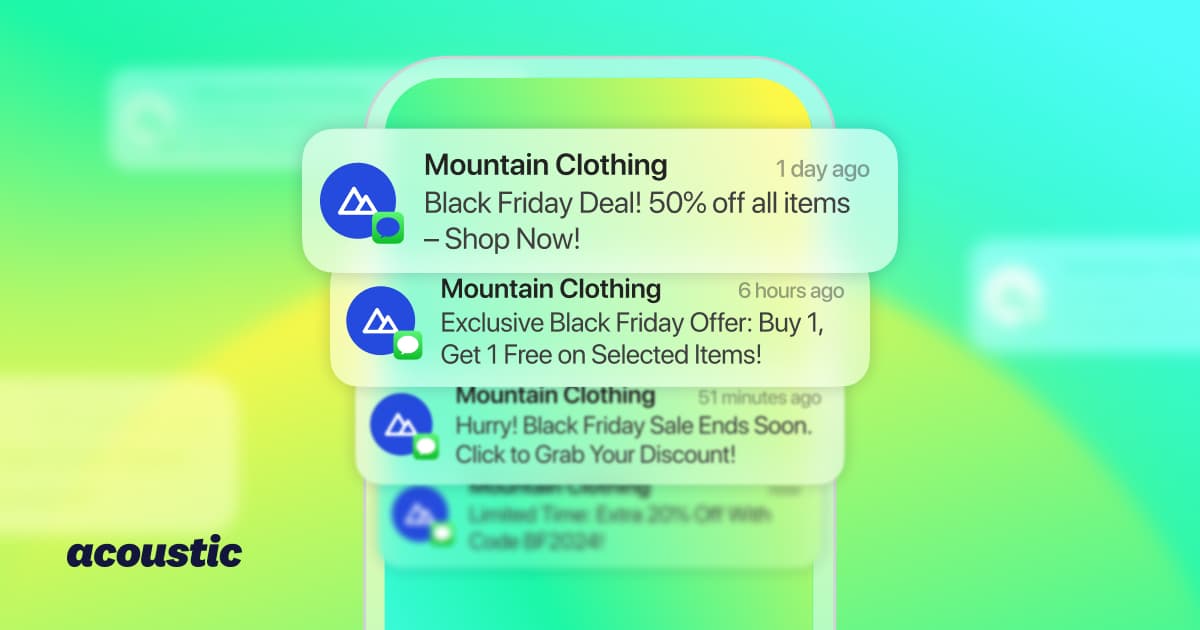SMS can be a game changer for marketing teams looking to reach their audience away from the crowded email inbox. And this can play a crucial role for high-volume campaigns like the ones on Black Friday and Cyber Monday (BFCM), where customers see an outsized amount of marketing messages flood their emails.
SMS offers immediacy, as well as high engagement rates, which can be helpful during a high-traffic time of year. But successfully building and executing these campaigns requires some layers of complexity. In this article, we’ll review how SMS deliverability works, and best practices to implement to help you ensure successful outcomes.
How does SMS deliverability work?
SMS deliverability refers to the ability of a message to be successfully sent and received by the end user. This can be impacted by factors including:
- Carrier filtering
- Opt-in processes
- Timing
- Originating code or sender ID
- And sometimes, volume
High deliverability guarantees that messages reach subscribers’ phones and that time-sensitive promotions are delivered promptly. But across regions, there are carrier-specific regulations that significantly impact SMS deliverability – and it’s important to be familiar with the nuances in any region where you’re sending communications. For Acoustic customers, when you onboard with SMS, our professional services team will help you handle regional regulations as well as compliance requirements for your SMS sends based on the destination of your messages.
The path taken by an SMS message is more complicated than you may think – here's an illustration of the steps to delivery:

Each region can have its own rules about SMS traffic that they use to reduce spam or fraud, especially for some of the more regulated codes. Additionally, many carriers monitor traffic for high volumes of SMS to avoid spam-like behavior and may filter messages that seem too promotional or are sent without proper consent. For optimal deliverability, it’s essential to follow carrier guidelines on message volume, content, and frequency, while using sender IDs that are verified or pre-approved by carriers.
6 best practices for maximizing SMS deliverability
1. Get proper opt-in and consent: To improve overall deliverability, it’s essential to get explicit permission from recipients to avoid getting caught by carrier filters. Also include a clear opt-out option and remind customers how or why they were opted-in to these communications. And along the way, be sure to comply with any relevant regional regulations like GDPR (General Data Protection Regulation), CTIA (Cellular Telephone Industries Association), TCPA (Telephone Consumer Protection Act), or T-Mobile Code of Conduct guidelines.
2. Timing and frequency: SMS works best when the messages are timely and relevant to the recipient – especially during BFCM when many customers can feel bombarded by marketing. Don’t send too many messages, as this can result in high churn. And avoid sending messages at inappropriate times – best practice is to send during the late afternoon or on weekends. In fact, some regions even have regulations around these timing guidelines, so be sure to check before sending.
3. Segmentation and personalization: To send relevant and timely messages, SMS communications should be targeted based on individual customer behavior, preferences, or interactions. Personalizing the content you send will help increase the likelihood that customers will engage. Be sure to also base your segmentation on location to perfect your timing.
4. Keep it concise: SMS has a 160-character limit, so put your key information first and keep your message short. This means using shortened, trackable links to keep your message short – or even choosing to use branded trackable links to make the message more recognizable. And don’t forget to state who the message is from.
5. Monitor SMS campaign performance: Use real-time analytics and reporting to measure delivery rates, failed rates, and engagement metrics like clicks. This can help inform your strategy moving forward. To figure out what works best, test different message types, offers, and timing to continuously optimize deliverability and engagement.
6. Use short codes, verified sender IDs, and long codes (or, 10 DLC): Each of these can help ensure messages aren’t blocked by carriers.
- A short code is available across regions and is a five- to six-digit number used for high-volume SMS campaigns. Unlike standard phone numbers, which are longer, short codes are easier for customers to remember and recognize. They can be dedicated to your brand or shared by multiple brands and can help with higher deliverability rates, sending large volumes of messages, and building customer trust. Businesses can lease short codes through service providers or aggregators approved by mobile carriers, but it’s important to plan ahead because short code approval can take weeks, depending on the country and carrier.
- A sender ID is the name in the “from” field – for example, your brand’s name. Note that sender IDs are not available in the United States. Elsewhere, these can be used to help with deliverability, as carriers prioritize verified sender IDs, and they also can help prevent scammers from impersonating your brand. As a result, they are useful for establishing brand recognition and trust with your customers. In many regions, businesses must register their Sender IDs with carriers. This process varies by country.
- Long codes, which are referred to as a 10 DLC in the United States, are local, long code phone numbers that networks approve for SMS messaging from marketers. A brand will need to get approval by registering the number with a verified 10 DLC brand and campaign, and they have the capacity to send somewhat large volumes of SMS messages.
Leverage SMS as a critical channel for building customer connections
SMS messages have proven to offer successful results as an alternative to emails – especially during busy periods like the holiday season – and therefore are an essential addition to a robust multichannel marketing strategy. This additional channel proves powerful when it comes to timely promotions with better conversion and customer retention rates. Ultimately, we do recommend considering a multichannel strategy using a mix of email and SMS to optimize outreach, increase engagement, and target subscribers who view SMS as their preferred channel.
To learn more about using SMS as channel in your marketing mix, find out how you can optimize your process, explore multichannel journeys, or review your SMS strategy, reach out to a knowledgeable member of our team.
 Principal Consultant, Professional Services
Principal Consultant, Professional ServicesTheo Docherty
Caroline brings a wealth of experience to the table, especially when it comes to bridging the gap between strategy and execution. With over 15 years of consultancy and marketing experience, she has developed effective approaches to craft tailored solutions that optimize customer experience and drive conversion. Her strength lies in her deep strategic marketing knowledge, which is key when adapting to various industries. She focuses heavily on data-driven decisions, trends, customer journey mapping, and testing.

